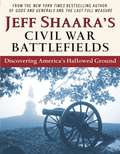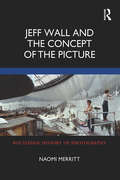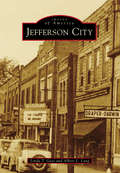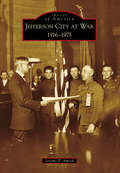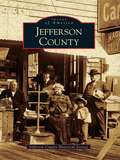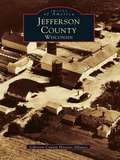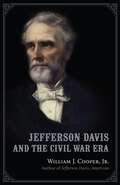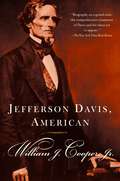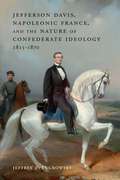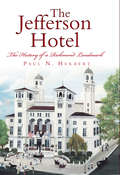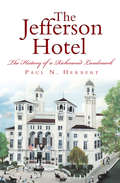- Table View
- List View
Jeff Shaara's Civil War Battlefields: Discovering America's Hallowed Ground
by Jeff ShaaraTRAVEL THROUGH A PIVOTAL TIME IN AMERICAN HISTORY. Jeff Shaara, America's premier Civil War novelist, gives a remarkable guided tour of the ten Civil War battlefields every American should visit: Shiloh, Antietam, Fredericksburg/Chancellorsville, Gettysburg, Vicksburg, New Market, Chickamauga, the Wilderness/Spotsylvania, Cold Harbor, and Petersburg/Appomattox. Shaara explores the history, the people, and the places that capture the true meaning and magnitude of the conflict and provides* engaging narratives of the war's crucial battles* intriguing historical footnotes about each site* photographs of the locations-then and now* detailed maps of the battle scenes* fascinating sidebars with related points of interest. From Antietam to Gettysburg to Vicksburg, and to the many poignant destinations in between, Jeff Shaara's Civil War Battlefields is the ideal guide for casual tourists and Civil War enthusiasts alike. From the Trade Paperback edition.
Jeff Shaara: Three Novels of World War II
by Jeff ShaaraJeff Shaara has written vivid, perceptive portraits of America's wars that have thrilled and mesmerized readers across generations. Collected for the first time in this eBook volume are Jeff Shaara's epic New York Times bestselling novels of World War II: The Rising Tide, The Steel Wave, and No Less Than Victory. As the United States wades into the shifting tides of war, Shaara details every move--the tank battles along the Mediterranean coast, the audacious invasion at Omaha Beach, the deadly final spasms of the Third Reich. He brings to life such figures as Eisenhower and Patton, as well as the courageous men on the front lines of battle. On full display throughout is the inimitable style and striking narrative range that have made Jeff Shaara such an esteemed and essential chronicler of the American age. Contains an excerpt from Jeff Shaara's acclaimed new novel of World War II in the Pacific, The Final Storm, which Booklist called "extraordinarily evocative."
Jeff Wall and the Concept of the Picture (Routledge History of Photography)
by Naomi MerrittThis book grapples with fundamental questions about the evolving nature of pictorial representation, and the role photography has played in this ongoing process. These issues are explored through a close analysis of key themes that underpin the photography practice of Canadian artist Jeff Wall and through examining important works that have defined his oeuvre. Wall’s strategic revival of ‘the picture’ has had a resounding influence on the development of contemporary art photography, by expanding the conceptual and technical frameworks of the medium and introducing a self-reflexive criticality. Naomi Merritt brings a new and original contribution to the scholarship on one of the most significant figures to have shaped the course of contemporary art photography since the 1970s and shines a light on the multilayered connections between photography and art. This book will be of interest to scholars in the history of photography, art and visual culture, and contemporary art history.
Jefferson City (Images of America)
by Albert L. Lang Linda T. GassIn 1788, Adam and Elizabeth Peck followed the Holston River from Virginia into east Tennessee and settled in what would become Mossy Creek. Utilizing the waterway, the Pecks' gristmill thrived within a growing community. The outbreak of the Civil War brought the Battle of Mossy Creek on December 29, 1863. During the next century, zinc mining, the establishment of Mossy Creek Missionary Baptist Seminary (now Carson-Newman University), and the town's inclusion as a stop on the new railroad ushered a steady flow of people to this picturesque region of promise. In 1901, Mossy Creek joined the Carsonville and Frame Addition communities to be incorporated as Jefferson City. The Tennessee Valley Authority began work in 1940 on nearby Cherokee Dam, generating both jobs and tourism.
Jefferson City at War: 1916-1975 (Images of America)
by Jeremy P. AmickJefferson City has a unique and enduring legacy of brave individuals banding together to answer the nation's call to arms. The Missouri National Guard's Company L, 2nd Infantry mobilized in support of the Mexican Border War in 1916 and later federalized for deployment during the Great War. Local youth scrambled to recruiting stations for a chance to join in the fray against Germany and Japan during World War II. Later, brave residents found themselves in the Korea peninsula or the jungles of Vietnam. It is clear that the Jefferson City community has a history of embracing the groundswell of patriotic pride that emerges in support of those who chose to fight--and sometimes lay down their lives--for a cause they view as greater than themselves.
Jefferson County
by Jefferson County Historical SocietyFounded by optimistic speculators with dreams of commercial empires that never materialized, Jefferson County is located on Washington's Olympic Peninsula. It stretches from spectacular Pacific Ocean beaches on the west and the Strait of Juan de Fuca on the north to the forested banks of the Hood Canal on the east. Created by the Oregon territorial legislature in 1852 and redefined by the Washington Territorial Legislature in 1877, it was named for Pres. Thomas Jefferson. Scenic Olympic National Park and Olympic National Forest occupy 60 percent of the county, and important industries in the region have included logging, pulp and paper, fishing, dairy farming, boatbuilding, and other marine-related businesses. Today the county has been discovered by artists, writers, poets, retirees, and tourists drawn to its unmatched scenery, mild weather, outstanding recreational opportunities, and the absence of urban stress.
Jefferson County, Wisconsin (Images of America)
by Jefferson County Historic AllianceJefferson County holds a unique place in the history of the state of Wisconsin. Founded in 1836 by Yankee settlers from New England, it began as an agriculturally-based county but soon rose to prominence as the cradle of the dairy industry. Nestled in the valley of the Rock River in southeastern Wisconsin, Jefferson County has always figured prominently in the history of the state due to its proximity to both Milwaukee, Wisconsin's largest city, and Madison, the state capital. Jefferson County, Wisconsin looks at the history of this area from 1836 to the present day. The historic images and informative text allow the reader to view changes in industry, gain greater insight into the history of education, and better understand the historic roles that religion and the ever-important rivers have played in defining Jefferson County. By the beginning of the twentieth century, and for many years after, Jefferson County was the leader in the dairy industry. Education also played an important role in the makeup of the county's character. Such important educational milestones as the first kindergarten in America, founded in Watertown in 1856, and the first free textbooks in the state bearwitness to the county's commitment to the educational betterment of its children. Since the 1960s, much has changed in Jefferson County, and this book will serve as a permanent record of itswonderful history, which is sometimes too easily forgotten.
Jefferson Davis and the Civil War Era
by William J. Jr.In his masterpiece, Jefferson Davis, American, William J. Cooper, Jr., crafted a sweeping, definitive biography and established himself as the foremost scholar on the intriguing Confederate president. Cooper narrows his focus considerably in Jefferson Davis and the Civil War Era, training his expert eye specifically on Davis's participation in and influence on events central to the American Civil War. Nine self-contained essays address how Davis reacted to and dealt with a variety of issues that were key to the coming of the war, the war itself, or in memorializing the war, sharply illuminating Davis's role during those turbulent years.Cooper opens with an analysis of Davis as an antebellum politician, challenging the standard view of Davis as either a dogmatic priest of principle or an inept bureaucrat. Next, he looks closely at Davis's complex association with secession, which included, surprisingly, a profound devotion to the Union. Six studies explore Davis and the Confederate experience, with topics including states' rights, the politics of command and strategic decisions, Davis in the role of war leader, the war in the West, and the meaning of the war. The final essay compares and contrasts Davis's first inauguration in Montgomery, Alabama, in 1861 with a little-known dedication of a monument to Confederate soldiers in the same city twenty-five years later. In 1886, Davis -- an old man of seventy-eight and in poor health -- had himself become a living monument, Cooper explains, and was an essential element in the formation of the Lost Cause ideology.Cooper's succinct interpretations provide straightforward, compact, and deceptively deep new approaches to understanding Davis during the most critical time in his life. Certain to stimulate further thought and spark debate, Jefferson Davis and the Civil War Era offers rare insight into one of American history's most complicated and provocative figures.
Jefferson Davis, American (Vintage Civil War Library)
by William J. CooperFrom a distinguished historian of the America South comes this thoroughly human portrait of the complex man at the center of our nation's most epic struggle.Jefferson Davis initially did not wish to leave the Union-as the son of a veteran of the American Revolution and as a soldier and senator, he considered himself a patriot. William J. Cooper shows us how Davis' initial reluctance turned into absolute commitment to the Confederacy. He provides a thorough account of Davis' life, both as the Confederate President and in the years before and after the war. Elegantly written and impeccably researched, Jefferson Davis, American is the definitive examination of one of the most enigmatic figures in our nation's history.From the Trade Paperback edition.
Jefferson Davis, Napoleonic France, and the Nature of Confederate Ideology, 1815-1870
by Jeffrey ZvengrowskiIn this highly original study of Confederate ideology and politics, Jeffrey Zvengrowski suggests that Confederate president Jefferson Davis and his supporters saw Bonapartist France as a model for the Confederate States of America. They viewed themselves as struggling not so much for the preservation of slavery but for antebellum Democratic ideals of equality and white supremacy. The faction dominated the Confederate government and deemed Republicans a coalition controlled by pro-British abolitionists championing inequality among whites. Like Napoleon I and Napoleon III, pro-Davis Confederates desired to build an industrial nation-state capable of waging Napoleonic-style warfare with large conscripted armies. States’ rights, they believed, should not preclude the national government from exercising power. Anglophile anti-Davis Confederates, in contrast, advocated inequality among whites, favored radical states’ rights, and supported slavery-in-the-abstract theories that were dismissive of white supremacy. Having opposed pro-Davis Democrats before the war, they preferred decentralized guerrilla warfare to Napoleonic campaigns and hoped for support from Britain. The Confederacy, they avowed, would willingly become a de facto British agricultural colony upon achieving independence. Pro-Davis Confederates, wanted the Confederacy to become an ally of France and protector of sympathetic northern states. Zvengrowski traces the origins of the pro-Davis Confederate ideology to Jeffersonian Democrats and their faction of War Hawks, who lost power on the national level in the 1820s but regained it during Davis' term as secretary of war. Davis used this position to cultivate friendly relations with France and later warned northerners that the South would secede if Republicans captured the White House. When Lincoln won the 1860 election, Davis endorsed secession. The ideological heirs of the pro-British faction soon came to loathe Davis for antagonizing Britain and for offering to accept gradual emancipation in exchange for direct assistance from French soldiers in Mexico. Zvengrowski’s important new interpretation of Confederate ideology situates the Civil War in a global context of imperial competition. It also shows how anti-Davis ex-Confederates came to dominate the postwar South and obscure the true nature of Confederate ideology. Furthermore, it updates the biographies of familiar characters: John C. Calhoun, who befriended Bonapartist officers; Davis, who was as much a Francophile as his namesake, Thomas Jefferson; and Robert E. Lee, who as West Point’s superintendent mentored a grand-nephew of Napoleon I.
Jefferson Davis: The Essential Writings
by Jefferson Davis William J. CooperJefferson Davis is one of the most complex and controversial figures in American political history (and the man whom Oscar Wilde wanted to meet more than anyone when he made his tour of the United States). Elected president of the Confederacy and later accused of participating in the assassination of Abraham Lincoln, he is a source of ongoing dissension between northerners and southerners. This volume, the first of its kind, is a selected collection of his writings culled in large part from the authoritative Papers of Jefferson Davis, a multivolume edition of his letters and speeches published by the Louisiana State University Press, and includes thirteen documents from manuscript collections and one privately held document that have never before appeared in a modern scholarly edition. From letters as a college student to his sister, to major speeches on the Constitution, slavery, and sectional issues, to his farewell to the U.S. Senate, to his inaugural address as Confederate president, to letters from prison to his wife, these selected pieces present the many faces of the enigmatic Jefferson Davis.As William J. Cooper, Jr., writes in his Introduction, "Davis's notability does not come solely from his crucial role in the Civil War. Born on the Kentucky frontier in the first decade of the nineteenth century, he witnessed and participated in the epochal transformation of the United States from a fledgling country to a strong nation spanning the continent. In his earliest years his father moved farther south and west to Mississippi. As a young army officer just out of West Point, he served on the northwestern and southwestern frontiers in an army whose chief mission was to protect settlers surging westward. Then, in 1846 and 1847, as colonel of the First Mississippi Regiment, he fought in the Mexican War, which resulted in 1848 in the Mexican Cession, a massive addition to the United States of some 500,000 square miles, including California and the modern Southwest. As secretary of war and U.S. senator in the 1850s, he advocated government support for the building of a transcontinental railroad that he believed essential to bind the nation from ocean to ocean."From the Hardcover edition.
Jefferson Hotel, The: The History of a Richmond Landmark
by Paul N. HerbertDesigned by Richmond visionary Lewis Ginter, The Jefferson Hotel has been an icon in the community since 1895. From the alligators that used to roam the elegant lobby to the speakeasy housed within during Prohibition, the hotel has a fascinating and unparalleled history. Playing host to cultural icons like Charles Lindbergh and F. Scott Fitzgerald and surviving the Great Depression and catastrophic fires, the hotel has remained an important landmark throughout Richmond's history. Join local historian Paul Herbert as he recounts stories of heiresses, actors, musicians and celebrities in this all-encompassing history of The Jefferson, a volume bound to delight anyone who has ever stayed within its treasured walls.
Jefferson Hotel, The: The History of a Richmond Landmark (Landmarks)
by Paul N. HerbertDesigned by Richmond visionary Lewis Ginter, The Jefferson Hotel has been an icon in the community since 1895. From the alligators that used to roam the elegant lobby to the speakeasy housed within during Prohibition, the hotel has a fascinating and unparalleled history. Playing host to cultural icons like Charles Lindbergh and F. Scott Fitzgerald and surviving the Great Depression and catastrophic fires, the hotel has remained an important landmark throughout Richmond's history. Join local historian Paul Herbert as he recounts stories of heiresses, actors, musicians and celebrities in this all-encompassing history of The Jefferson, a volume bound to delight anyone who has ever stayed within its treasured walls.
Jefferson Memorial: A Monument to Greatness
by Joseph FerryThe third president of the United States, Thomas Jefferson, was much more than just a politician--he was a writer, scientist, architect, and scholar who was considered one of the most brilliant figures of his age. To commemorate Jefferson's numerous accomplishments, a rotunda was constructed on the National Mall in Washington, D.C. Within is a statue of Jefferson, while on the walls nearby are quotations from some of his most famous writings, including the Declaration of Independence. The Jefferson Memorial is a symbol of American liberty. Surrounded by cherry blossom trees, it remains a popular site for reflection and inspiration.
Jefferson Square
by Noel B. GersonJefferson Square was a multi-million dollar culture center…but there was nothing at all cultural about some of the things that happened there during its grand opening in the Sixties.At the Repertory Theater, a play called Confessional was in rehearsal. Some called it dramatic literature. Others considered it a tasteless exploitation of the playwright&’s former marriage to America&’s queen of sex. In the expensive interior of Symphony Hall, the brilliant and erratic conductor of the Jefferson Square Symphony Orchestra was working feverishly on a new concerto while his private life was rushing toward its own scandalous crescendo. In the board room, the dream of the state&’s governor for a presidential nomination was interrupted by the discovery that Jefferson Square was making this rich man richer. And in the executive offices, where architects&’ drawings were still being argued over, Jefferson Square&’s recently hired cultural director was being tempted to destroy what he had been employed to hold together.Jefferson Square provides a fascinating glimpse of life behind the scenes in the midst of the creation of a new urban cultural epicenter, a symbol of the gentrification forcing out longtime neighborhood inhabitants. From the glitz and the glamor of Jefferson Square proper, to the hardships faced by residents of the condemned projects in the area, Gerson brings microcosms of the Sixties to Technicolor life.
Jefferson and Monticello: The Biography of a Builder
by Jack McLaughlinA National Book Award nominee in 1988, Jack McLaughlin's biography tells the life of Thomas Jefferson as seen through the prism of his love affair with Monticello. For over half a century, it was his consuming passion, his most serious amusement. With a sure command of sources and skilled intuitive understanding of Jefferson, McLaughlin crafts and uncommon portrait of builder and building alike. En route he tells us much about life in Virginia; about Monticello's craftsmen and how they worked their materials; about slavery, class, and family; and, above all, about the multiplicity of domestic concerns that preoccupied this complex man. It is an engaging and incisive look at the eighteenth-century mind: systematic, rational, and curious, but also playful, comfort-loving, and amusing. Ultimately, it provides readers with great insight into daily life in Colonial and Federal America.
Jefferson and the Gun-Men
by M. R. MontgomeryIn 1803, Thomas Jefferson made a visionary purchase that opened an American frontier so vast as to defy the imagination -- nearly all the land from the Mississippi to the Rockies. Few know, however, that the intrigue behind the exploration and opening of the Louisiana Territory was almost as vast as the land itself. Even as Meriwether Lewis and William Clark set out on their legendary journey to the Pacific Ocean, other forces were taking the measure of the land with far darker ambitions. Just three ...
Jefferson and the Virginians: Democracy, Constitutions, and Empire (Walter Lynwood Fleming Lectures in Southern History)
by Peter OnufIn Jefferson and the Virginians, renowned scholar Peter S. Onuf examines the ways in which Thomas Jefferson and his fellow Virginians—George Washington, James Madison, and Patrick Henry—both conceptualized their home state from a political and cultural perspective, and understood its position in the new American union. The conversations Onuf reconstructs offer glimpses into the struggle to define Virginia—and America—within the context of the upheaval of the Revolutionary War. Onuf also demonstrates why Jefferson’s identity as a Virginian obscures more than it illuminates about his ideology and career.Onuf contends that Jefferson and his interlocutors sought to define Virginia’s character as a self-constituted commonwealth and to determine the state’s place in the American union during an era of constitutional change and political polarization. Thus, the outcome of the American Revolution led to ongoing controversies over the identity of Virginians and Americans as a “people” or “peoples”; over Virginia’s boundaries and jurisdiction within the union; and over the system of government in Virginia and for the states collectively. Each debate required a balanced consideration of corporate identity and collective interests, which inevitably raised broader questions about the character of the Articles of Confederation and the newly formed federal union. Onuf’s well-researched study reveals how this indeterminacy demanded definition and, likewise, how the need for definition prompted further controversy.
Jefferson on Display: Attire, Etiquette, and the Art of Presentation (Jeffersonian America)
by G. S. WilsonWhen we think of Thomas Jefferson, a certain picture comes to mind for some of us, combining his physical appearance with our perception of his character. During Jefferson’s lifetime this image was already taking shape, helped along by his own assiduous cultivation. In Jefferson on Display, G. S. Wilson draws on a broad array of sources to show how Jefferson fashioned his public persona to promote his political agenda. During his long career, his image shifted from cosmopolitan intellectual to man of the people. As president he kept friends and foes guessing: he might appear unpredictably in old, worn, and out-of-date clothing with hair unkempt, yet he could as easily play the polished gentleman in a black suit, as he hosted small dinners in the President’s House that were noted for their French-inspired food and fine European wines. Even in retirement his image continued to evolve, as guests at Monticello reported being met by the Sage clothed in rough fabrics that he proudly claimed were created from his own merino sheep, leading Americans by example to manufacture their own clothing, free of Europe.By paying close attention to Jefferson’s controversial clothing choices and physical appearance--as well as his use of portraiture, architecture, and the polite refinements of dining, grooming, and conversation--Wilson provides invaluable new insight into this perplexing founder.
Jefferson on Freedom: Wisdom, Advice, and Hints on Freedom, Democracy, and the American Way
by Thomas JeffersonThomas Jefferson is most famous for the writing of the Declaration of Independence, which espouses the general principles of freedom and democracies that Americans hold dear. Now, collected here for the first time, is this historical American document, as well as several of his other famous writings. Included in this book are excerpts from his only full-length book, Notes on the State of Virginia, letters to Samual Kercheval and Edward Carrington on liberal democracy and freedom, and an exchange with Danbury Baptists regarding the right to religious freedom to his manual on parliamentary policy. Jefferson provides excellent and timeless quotes on attaining freedom and living a democratic life.
Jefferson vs. Hamilton: Confrontations That Shaped A Nation (The Bedford Series In History And Culture)
by Noble E. Cunningham Jr.This documentary study of Thomas Jefferson and Alexander Hamilton focuses on their differing views of society and government in the formative years of the new American nation. Interweaving more than 40 documents into 7 chronological chapters, the text follows the lives and careers of the two men from their youth, through the Revolutionary War, to the death of Hamilton in 1804. In each chapter, generous excerpts from their public papers and private letters reveal the two men’s often divergent views on government and the Constitution, economic and foreign policy, and the military, and illustrate the roles they played in the emergence of political parties. Reading Jefferson’s First Inaugural Address, the Report on Public Credit, the Kentucky Resolutions, and a host of other documents, students can explore firsthand the two men’s philosophies and the impact these had on the emerging nation. Also included are 10 illustrations, a Jefferson/Hamilton chronology, a bibliography, and an index.
Jefferson vs. the Patent Trolls: A Populist Vision of Intellectual Property Rights
by Jeffrey H. MatsuuraOf all the founding fathers, Thomas Jefferson had the most substantial direct experience with the issues surrounding intellectual property rights and their impact on creativity, invention, and innovation. In our own digital age, in which IP has again become the object of intense debate, his voice remains one of the most vital in American history on this crucial subject.Jefferson lived in a time of immense change, when inventions and other creative works impacted the world profoundly. In this atmosphere it became clear that the developers of creative works and the users of those works often have competing interests. Jefferson appreciated as well as anyone that the originators of ideas needed legal protection. He also knew that innovation was crucial for a nation's economic prosperity as well as its political health, and that rights should not become barriers.Jefferson was in a unique position to understand the issues of intellectual property rights. His pronouncements on these issues were those not of a scholar but, rather, of a practitioner. As a scientist, author, and inventor, he was a prolific creator. He was also a tireless consumer of others' works. As America's first patent commissioner, he decided which ideas merited protection and effectively created the patent review process. Jeffrey Matsuura profiles Jefferson's diverse and substantial experience with these issues and discusses the lessons Jefferson's efforts offer us today, as we grapple with many of the same challenges of balancing IP rights against an effort to foster creativity and innovation. Without inserting Jefferson anachronistically into the current debate, Matsuura does not shy away from positing where in the spectrum of opinion Jefferson's ideas lie. For lawyers, legal and technology historians, and entrepreneurs, Matsuura offers a fresh, historically informed perspective on a current issue of major importance.
Jefferson's America: The President, the Purchase, and the Explorers Who Transformed a Nation
by Julie M. FensterThe surprising story of how Thomas Jefferson commanded an unrivaled age of American exploration--and in presiding over that era of discovery, forged a great nation. At the dawn of the nineteenth century, as Britain, France, Spain, and the United States all jockeyed for control of the vast expanses west of the Mississippi River, the stakes for American expansion were incalculably high. Even after the American purchase of the Louisiana Territory, Spain still coveted that land and was prepared to employ any means to retain it. With war expected at any moment, Jefferson played a game of strategy, putting on the ground the only Americans he could: a cadre of explorers who finally annexed it through courageous investigation. Responsible for orchestrating the American push into the continent was President Thomas Jefferson. He most famously recruited Meriwether Lewis and William Clark, who led the Corps of Discovery to the Pacific, but at the same time there were other teams who did the same work, in places where it was even more crucial. William Dunbar, George Hunter, Thomas Freeman, Peter Custis, and the dauntless Zebulon Pike--all were dispatched on urgent missions to map the frontier and keep up a steady correspondence with Washington about their findings. But they weren't always well-matched--with each other and certainly not with a Spanish army of a thousand soldiers or more. These tensions threatened to undermine Jefferson's goals for the nascent country, leaving the United States in danger of losing its foothold in the West. Deeply researched and inspiringly told, Jefferson's America rediscovers the robust and often harrowing action from these seminal expeditions and illuminates the president's vision for a continental America.
Jefferson's Body: A Corporeal Biography (Jeffersonian America)
by Maurizio ValsaniaWhat did Thomas Jefferson look like? How did he carry himself? Such questions, reasonable to ask as we look back on a person who lived in an era before photography, are the starting point for this boldly original new work. Maurizio Valsania considers all aspects of Jefferson’s complex conception of "the body," from eighteenth-century clothing and fashion to manners, adornment, posture, gesture, and visual and material culture. Drawing also from the fields of medical science, psychology, and cultural anthropology, the author conjures a vivid and detailed re-creation of the third president as a living, breathing—and pondering—human being.Having situated Jefferson in his own body, Valsania looks at the embodied Jefferson in the world of his fellow humans. Any one of the other people in Jefferson’s society—whether that other person was male or female, free or enslaved, African American or Native American—was a critical counterexample for the eighteenth-century Virginian to define himself against, and Valsania’s explorations here lead to numerous insightful discoveries about race, gender, and structures of power. The first comprehensive exploration of Jefferson’s corporeal world, Jefferson’s Body brings the man vividly to life for the modern reader while deepening our understanding of what it meant to Jefferson to be alive.
Jefferson's Children: The Story of One American Family
by Jane Feldman Shannon LaNierNow available in ebook format--one of the important books that marked the beginning of the ongoing conversation about slavery and our nation's history. From the sixth great-grandson of Thomas Jefferson and enslaved woman Sally Hemmings comes an anthology of Jefferson's living descendants.Told in the style of a family photo album—with a combination of photographs and interviews—Jefferson&’s Children is the riveting story of Thomas Jefferson and Sally Hemming&’s sixth great-grandson, Shannon Lanier&’s, travels across the country to meet his relatives from both sides of the family. The profiles contained chart the multiple perspectives of Jefferson&’s and Hemming&’s descendants, from those who embrace their heritage to those who want nothing to do with Jefferson&’s legacy. A fascinating picture soon emerges, one that begins with a pairing of two individuals with vastly disparate levels of power—on the one side, the third president of the United States and the author of the Declaration of Independence; on the other, the woman who was his property—and that ultimately represents America&’s complicated history with issues of diversity and race and the unusual ways in which we define family.An ALA Best Book for Young Adults &“The portraits that emerge are as generous and jumbled as America itself.&” —The New York Times &“A book about American history, racial identity and the bonds of family that will help young people navigate these difficult areas.&” —Black Issues Book Review
